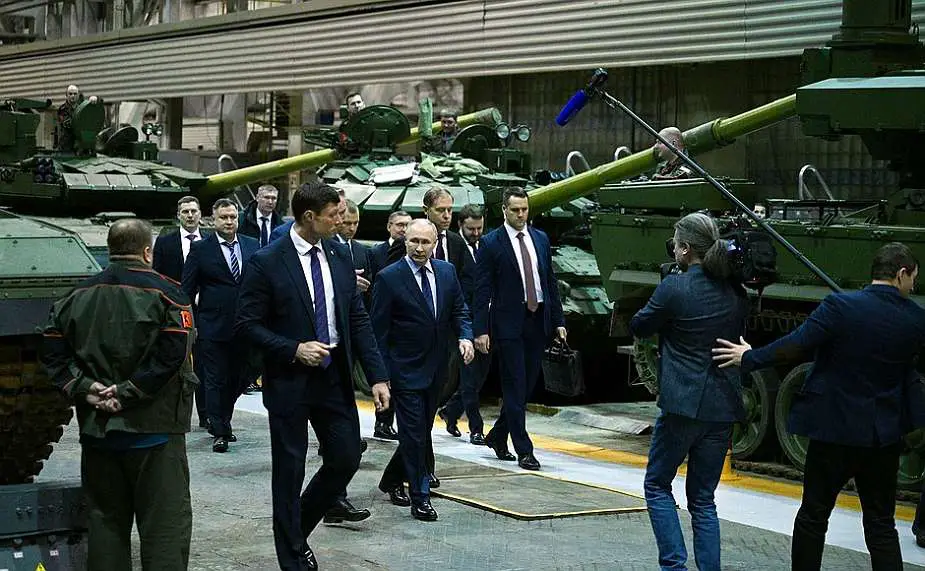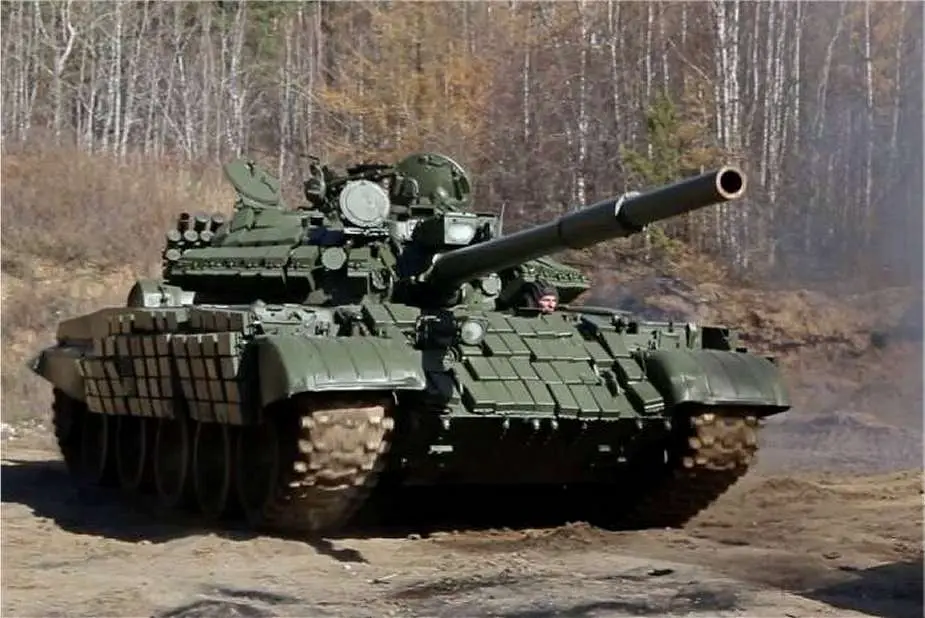Breaking news
British Intelligence Reveals Russian Military Equipment Production Set to Surge in 2024.
In a recent significant development reported by the British Army Intelligence Services, Russia's defense industry has seen a marked increase in the production of combat vehicles and military equipment throughout 2023. This escalation in manufacturing capabilities has been attributed to a series of strategic expansions and optimizations within the industry, including the enlargement of the workforce to approximately 3.5 million individuals, the extension of working shift patterns, and the revitalization of dormant production capacities.
Follow Army Recognition on Google News at this link

In February 2024, Russian President Vladimir Putin visited the facilities of Uralvagonzavod, the largest producer of main battle tanks in Russia. (Picture source Russian Government).
Notably, the production of artillery munitions has experienced a sharp rise in the past year, with expectations of further increases into 2024.
A considerable portion of this uptick in production stems from the refurbishment and modernization of existing combat vehicles, rather than the creation of new ones. For instance, the majority of main battle tanks produced last year were refurbished models. Despite these efforts, the British Army Intelligence reports suggest that the Russian defense industry still falls short of fully meeting the operational demands of the Russian armed forces engaged in Ukraine. However, it is assessed with high confidence that Russia will maintain a significant military materiel advantage over Ukraine throughout 2024.
In a related event, Russian President Vladimir Putin recently made headlines with his visit to the Uralvagonzavod, a key armored vehicle production facility located in the Ural city of Nizhny Tagil. This visit, which coincided with the delivery of the latest batch of T-90M Proryv tanks to the Russian military, underscored the nation's intensified focus on bolstering its military capabilities. President Putin praised the workers for achieving what he described as a fivefold increase in tank production since the onset of the conflict in Ukraine, highlighting the strategic importance of the Uralvagonzavod in Russia's military-industrial complex.
However, the exact number of T-90M tanks delivered to the Russian forces remains undisclosed, even as Kremlin-issued images suggest the preparation of a new batch for imminent deployment. This visit not only emphasizes the significance of the Uralvagonzavod in Russia's defense strategy but also signals the country's determined response to the ongoing military challenges in Ukraine, as the conflict approaches its third year.
Analysts view Russia's production surge as a direct response to the sustained losses of heavy vehicles in the conflict with Ukraine, reflecting the prolonged and attritional nature of the warfare. With Uralvagonzavod's storied history of producing over 100,000 military vehicles, Russia's latest moves indicate a steadfast commitment to maintaining a competitive edge on the battlefield, despite the complex dynamics of the Ukrainian conflict.

Due to significant losses of modern tanks in the ongoing conflict in Ukraine, the Russian army has deployed upgraded T-62 main battle tanks." (Picture source: social network)
In response to significant losses of modern tanks in the ongoing Ukraine conflict, Russia has been actively deploying older Soviet-era tanks, including the T-54, T-55, and T-62 models, bolstered by upgrades to improve their combat effectiveness. Reports indicate that Russia has lost over 3,000 tanks since the beginning of the invasion, compelling it to draw from its vast reserves of older armored vehicles to maintain its operational capabilities. The British Army Intelligence services and various defense analysts have highlighted this strategy as part of Russia's broader approach to managing its military materiel advantage over Ukraine despite the qualitative shortcomings of these older tanks.
The T-54 and T-55, first produced in the late 1940s and entering service in 1958 respectively, have been pulled from storage and refurbished for deployment. These tanks, while technologically outdated, still offer some battlefield utility, especially in specific scenarios like asymmetric warfare or in defensive roles where their limitations may be less pronounced. Despite their simplicity and older design, these tanks are being utilized to compensate for the heavy losses of more advanced models, reflecting Russia's capacity to sustain prolonged military operations through volume.
The T-62, another Soviet-era tank first introduced over six decades ago, has also been upgraded and deployed in the conflict. These upgrades include the integration of modern thermal imaging sights, dozer blades for engineering tasks, and, in some cases, explosive reactive armor (ERA) to enhance their defensive capabilities. Despite these improvements, concerns remain regarding the T-62's vulnerability to modern anti-tank weapons, given its lack of ERA on some models and the challenges it faces against the advanced weaponry supplied to Ukraine by Western allies. The deployment of these older tanks, including the upgraded T-62 variants, signifies Russia's attempt to offset its significant armored losses and adapt its military strategy in the face of ongoing operational demands.
Together, the deployment and upgrading of the T-54, T-55, and T-62 tanks underscore Russia's broader military strategy in Ukraine, leveraging its extensive reserves of older armored vehicles to sustain its combat capabilities. While these efforts reflect a pragmatic approach to compensating for equipment losses, they also highlight the challenges Russia faces in confronting modern anti-tank systems and the evolving dynamics of the conflict.
Defense News March 2024























